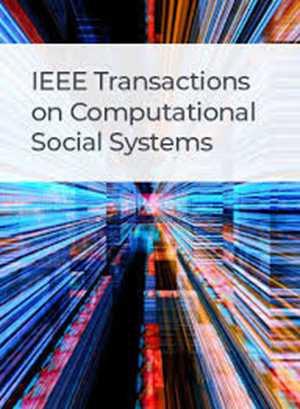CGNN:用于社交媒体机器人检测的兼容性感知图神经网络
IF 4.5
2区 计算机科学
Q1 COMPUTER SCIENCE, CYBERNETICS
IEEE Transactions on Computational Social Systems
Pub Date : 2024-06-05
DOI:10.1109/TCSS.2024.3396413
引用次数: 0
摘要
随着社交机器人的兴起和盛行,其对社会的负面影响逐渐被人们所认识,促使人们开始关注有效的检测和对策研究。近年来,图神经网络(GNN)得到了蓬勃发展,并被应用于社交僵尸的检测研究,有效提高了检测方法的性能。然而,现有的基于图神经网络的社交僵尸检测方法往往不能考虑社交媒体语境中用户之间的异构关联,尤其是社交僵尸与网络中人类社区的异构整合。为了应对这一挑战,我们提出了社交僵尸检测的异构兼容性视角,其中我们保留了社交媒体上下文中邻居之间不同关联的更详细信息。随后,我们开发了一种用于社交僵尸检测的兼容性感知图神经网络(CGNN)。图神经网络由一个高效的特征处理模块和一个轻量级兼容性感知图神经网络编码器组成,后者通过模拟异构兼容性函数增强了模型描绘异构邻居关系的能力。通过大量实验,我们发现在三个常用的社交僵尸检测基准上,我们的 CGNN 优于现有的最先进方法(SOTA),而与 SOTA 方法相比,CGNN 的参数大小仅为 SOTA 方法的 2%,训练时间仅为 SOTA 方法的 10%。最后,进一步的实验分析表明,CGNN 可以在很大程度上识别不同的边缘类别。这些发现以及消融研究为增强 GNN 在社交媒体僵尸检测任务中描绘异质邻居关联的能力提供了有力证据。本文章由计算机程序翻译,如有差异,请以英文原文为准。
CGNN: A Compatibility-Aware Graph Neural Network for Social Media Bot Detection
With the rise and prevalence of social bots, their negative impacts on society are gradually recognized, prompting research attention to effective detection and countermeasures. Recently, graph neural networks (GNNs) have flourished and have been applied to social bot detection research, improving the performance of detection methods effectively. However, existing GNN-based social bot detection methods often fail to account for the heterogeneous associations among users within social media contexts, especially the heterogeneous integration of social bots into human communities within the network. To address this challenge, we propose a heterogeneous compatibility perspective for social bot detection, in which we preserve more detailed information about the varying associations between neighbors in social media contexts. Subsequently, we develop a compatibility-aware graph neural network (CGNN) for social bot detection. CGNN consists of an efficient feature processing module, and a lightweight compatibility-aware GNN encoder, which enhances the model’s capacity to depict heterogeneous neighbor relations by emulating the heterogeneous compatibility function. Through extensive experiments, we showed that our CGNN outperforms the existing state-of-the-art (SOTA) method on three commonly used social bot detection benchmarks while utilizing only about 2% of the parameter size and 10% of the training time compared with the SOTA method. Finally, further experimental analysis indicates that CGNN can identify different edge categories to a significant extent. These findings, along with the ablation study, provide strong evidence supporting the enhancement of GNN’s capacity to depict heterogeneous neighbor associations on social media bot detection tasks.
求助全文
通过发布文献求助,成功后即可免费获取论文全文。
去求助
来源期刊

IEEE Transactions on Computational Social Systems
Social Sciences-Social Sciences (miscellaneous)
CiteScore
10.00
自引率
20.00%
发文量
316
期刊介绍:
IEEE Transactions on Computational Social Systems focuses on such topics as modeling, simulation, analysis and understanding of social systems from the quantitative and/or computational perspective. "Systems" include man-man, man-machine and machine-machine organizations and adversarial situations as well as social media structures and their dynamics. More specifically, the proposed transactions publishes articles on modeling the dynamics of social systems, methodologies for incorporating and representing socio-cultural and behavioral aspects in computational modeling, analysis of social system behavior and structure, and paradigms for social systems modeling and simulation. The journal also features articles on social network dynamics, social intelligence and cognition, social systems design and architectures, socio-cultural modeling and representation, and computational behavior modeling, and their applications.
 求助内容:
求助内容: 应助结果提醒方式:
应助结果提醒方式:


